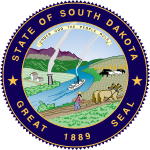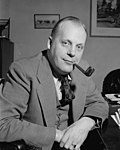
Karl Earl Mundt was an American educator and a Republican member of the United States Congress, representing South Dakota in the United States House of Representatives (1939–1948) and in the United States Senate (1948–1973).

Harlan John Bushfield was an American politician from South Dakota. He served as the 16th governor of South Dakota and as a United States senator.

George McGovern, a Democratic Party politician from South Dakota, was first elected to the United States House of Representatives to represent South Dakota's 1st congressional district in 1956. He was re-elected in 1958, before making an unsuccessful run for the United States Senate in 1960 against Republican incumbent Karl Earl Mundt. After serving in the John F. Kennedy administration as director of the Food for Peace program, McGovern ran again for the Senate and narrowly prevailed over appointed Senator Joseph H. Bottum. In 1968, McGovern unsuccessfully sought the Democratic Party's presidential nomination at the Democratic National Convention and was re-elected to the Senate over former Governor of South Dakota Archie M. Gubbrud. In 1972, McGovern was successful in his campaign for the Democratic presidential nomination, but lost the election in a landslide to incumbent President Richard Nixon. McGovern was re-elected to the Senate in 1974 over Vietnam War veteran Leo K. Thorsness, but lost re-election in 1980 to then-U.S. Representative James Abdnor. McGovern made a final unsuccessful run for president in 1984 United States presidential election.

The 1948 United States Senate election in South Dakota took place on November 2, 1948. Incumbent Republican Senator Harlan J. Bushfield, suffering from poor health, declined to run for re-election. On September 27, 1948, he died in office; his wife, Vera C. Bushfield, was appointed to succeed him. Congressman Karl E. Mundt easily won the Republican primary and advanced to the general election, where he was opposed by Democratic nominee John A. Engel, an attorney. Hundt defeated Engel in a landslide.

The 1956 United States Senate election in South Dakota took place on November 6, 1956. Incumbent Republican Senator Francis H. Case ran for re-election to a second term. In the general election, Case was opposed by former State Representative Kenneth Holum, who was the 1954 Democratic nominee for the U.S. Senate. Owing in part to anger among the state's farmers, the race between Case and Holum was quite close, with Holum leading Case on election night and only falling behind the next day. Case ended up narrowly winning re-election, defeating Holum by just 4,620 votes.

The 1920 United States Senate election in South Dakota took place on November 2, 1926. Incumbent Republican Senator Peter Norbeck ran for re-election to a second term. In the Republican primary, he faced former State Senator George J. Danforth, who had the support of Governor Carl Gunderson in an intra-party split between Norbeck and Gunderson. Norbeck defeated Danforth by a wide margin, and then faced former State Representative Charles J. Gunderson in the general election. Norbeck defeated Gunderson in a landslide to win re-election.
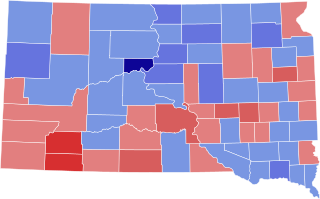
The 1930 United States Senate election in South Dakota took place on November 4, 1930. Incumbent Republican Senator William H. McMaster ran for re-election to a second term. After beating back a challenge in the Republican primary from former State Senator George J. Danforth, McMaster faced Democratic nominee William J. Bulow, the incumbent Governor, in the general election. As the Democratic Party performed well nationwide, Bulow narrowly defeated McMaster.

The 1936 United States Senate election in South Dakota took place on November 3, 1936. Incumbent Democratic Senator William J. Bulow ran for re-election to a second term. He was challenged by businessman Chan Gurney, who defeated former Congressman Charles A. Christopherson in the Republican primary. Bulow, likely aided by President Franklin D. Roosevelt's landslide victory in South Dakota, narrowly defeated Gurney to win his second term, though he significantly underperformed Roosevelt.

The 1932 United States Senate election in South Dakota took place on November 7, 1944. Incumbent Republican Senator Chan Gurney ran for re-election to a second term. He faced a strong challenge in the Republican primary from Lieutenant Governor A. C. Miller, who claimed that Gurney was too friendly to New Deal policies, but was defeated by Gurney by a wide margin. In the general election, Gurney faced former State Senator George M. Bradshaw, whom he defeated in a landslide as Thomas E. Dewey was decisively winning the state over President Franklin D. Roosevelt in the presidential election.

The 1954 United States Senate election in South Dakota took place on November 2, 1954. Incumbent Republican Senator Karl E. Mundt ran for re-election to his second term. He was opposed by former State Representative Kenneth Holum, the Democratic nominee. Mundt defeated Holum in a landslide to win re-election.

The 1962 United States Senate election in South Dakota took place on November 6, 1962. Incumbent Republican Senator Francis H. Case ran for re-election to a third term. He won the Republican primary against Attorney General A. C. Miller, but shortly after the primary, died. The Republican State Central Committee named Lieutenant Governor Joseph H. Bottum as Case's replacement on the ballot, and Governor Archie Gubbrud appointed Bottum to fill the vacancy caused by Case's death. In the general election, Bottum was opposed by Democratic nominee George McGovern, the Director of Food for Peace and the former U.S. Congressman from South Dakota's 1st congressional district. The contest between Bottum and McGovern was quite close, with McGovern narrowly defeating him for election by just 597 votes, making him the first Democrat to win a Senate election in South Dakota since William J. Bulow's win in 1936.

The 1966 United States Senate election in South Dakota took place on November 8, 1966. Incumbent Republican Senator Karl E. Mundt ran for re-election to his fourth term. He was challenged in the Republican primary by a John Birch Society member, but easily turned away the challenge. In the general election, he faced State Representative Donn Wright, the Democratic nominee. Owing in large part to the Republican landslide taking place nationwide, Mundt defeated Wright by an unprecedented margin.

The 1968 United States Senate election in South Dakota took place on November 5, 1968. Incumbent Democratic Senator George McGovern ran for re-election to a second term. He was challenged by former Governor Archie M. Gubbrud, who was persuaded to enter the race by the South Dakota Republican establishment. McGovern defeated Gubbrud by a wide margin, even as Richard Nixon was defeating Hubert Humphrey in the state's presidential election in a landslide.

The 1972 United States Senate election in South Dakota took place on November 7, 1972, concurrently with the U.S. presidential election as well as other elections to the United States Senate in other states as well as elections to the United States House of Representatives and various state and local elections.

The 1974 United States Senate election in South Dakota was held on November 5, 1974. Incumbent Democratic U.S. Senator George McGovern, who had lost the 1972 United States presidential election to Richard Nixon ran for reelection to a third term and won, despite having also lost his home state two years prior.
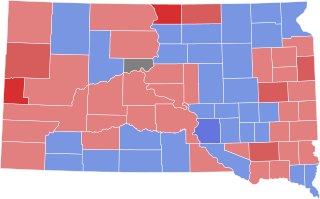
The 1938 United States Senate elections in South Dakota took place on November 8, 1938. Incumbent Republican Senator Peter Norbeck died in office on December 20, 1936. Herbert E. Hitchcock was appointed by Governor Tom Berry as Norbeck's replacement. Two elections for the same Senate seat were held on the same day; one as a special election to fill the remainder of Norbeck's six-year term, and another to select a Senator to serve the next six-year term.

The 1920 South Dakota gubernatorial election was held on November 2, 1920. Incumbent Republican Governor Peter Norbeck declined to run for re-election, instead choosing to run for the U.S. Senate. Lieutenant Governor William H. McMaster won the Republican primary and advanced to the general election, where he faced Nonpartisan League candidate Mark P. Bates and former State Senator William W. Howes, the Democratic nominee. The election was largely a replay of the 1918 election, with McMaster winning a large victory, Bates coming in second, and Howes coming in a distant third.
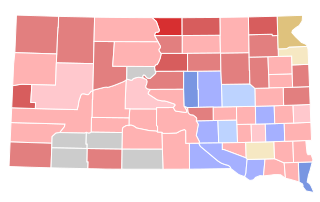
The 1922 South Dakota gubernatorial election was held on November 7, 1922. Incumbent Republican Governor William H. McMaster ran for re-election to a second term. After beating back a challenge in the Republican primary from perennial candidate George W. Egan, McMaster advanced to the general election, where he faced former State Senate President Louis N. Crill, the Democratic nominee, and suffragist Alice Lorraine Daly, the Nonpartisan League's nominee, and the first woman to run for governor. McMaster won by a large margin, but the race was considerably narrower than the 1920 election.

The 1936 South Dakota gubernatorial election was held on November 3, 1936. Incumbent Democratic Governor Tom Berry ran for re-election to a third term, the first Governor of South Dakota to do so. Berry was challenged by Republican Leslie Jensen, the former Collector of Internal Revenue for the state of South Dakota. Both Berry and Jensen won their primaries uncontested and advanced to the general election. Some drama surrounded the potential candidacy of Democratic State Auditor George O'Neill as an independent candidate for Governor or, in the alternative, his cross-party endorsement of Jensen; after initially announcing his campaign and hedging, O'Neill dropped out of the race in September and endorsed the Democratic ticket in the state, including Berry.

The 1942 South Dakota gubernatorial election was held on November 3, 1942. Incumbent Republican Governor Harlan J. Bushfield declined to seek re-election to a third term and instead successfully ran for the U.S. Senate. A crowded Republican primary developed to succeed him, and because no candidate received 35% of the vote, the nomination was decided at the state Republican convention, where former Attorney General Merrell Q. Sharpe, the second-place finisher in the primary, won the nomination. In the general election, Sharpe faced Democratic nominee Lewis W. Bicknell, the 1940 Democratic nominee for Governor. Aided by the national Republican landslide, Sharpe defeated Bicknell in a landslide.

